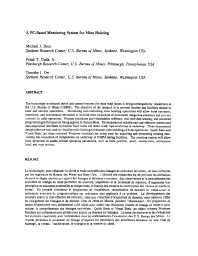Mining Publication: A PC-Based Monitoring System for Mine Hoisting
Original creation date: October 1995
The technology to enhance safety and control features for mine shaft hoists is being investigated by researchers at the U.S. Bureau of Mines (USBM). The objective of the research is to prevent injuries and fatalities related to hoist and elevator operations. Monitoring and controlling mine hoisting operations will allow hoist operators, inspectors, and maintenance personnel to increase their awareness of potentially dangerous situations and provide controls for safer operations. Process simulation and visualization software, real-time data sensing, and advanced programming techniques are being applied to this problem. Development of reliable and cost-effective sensors and data acquisition interfaces to monitor hoist loads and detect slack rope conditions is underway. Three-dimensional design software was used to visualize mine hoisting to enhance understanding of hoist operations. Quick Basic and Visual Basic (an object-oriented Windows interface) are being used for acquiring and processing hoisting data. Testing and evaluation of components are underway at USBM testing facilities. The resulting system will allow hoist personnel to assess critical operating parameters, such as hoist position, speed, acceleration, conveyance load, and rope tension.
Authors: MJ Beus, FT Duda, TJ Orr
Conference Paper - October 1995
NIOSHTIC2 Number: 20034283
In: Mitri HS, ed. Proceedings of the Third Canadian Conference on Computer Applications in the Mineral Industry. October 22-25, 1995, Montreal, Quebec, Canada.: McGill University, 1995; :646-653
See Also
- Developing Random Virtual Human Motions and Risky Work Behaviors for Studying Anthropotechnical Systems
- Development and Application of Reservoir Models and Artificial Neural Networks for Optimizing Ventilation Air Requirements in Development Mining of Coal Seams
- Machine Injury Prediction by Simulation Using Human Models
- Mining Roof Bolting Machine Safety: A Study of the Drill Boom Vertical Velocity
- Modeling and Prediction of Ventilation Methane Emissions of U.S. Longwall Mines Using Supervised Artificial Neural Networks
- Modernization and Further Development of the NIOSH Mine Emergency Response Training System (MERITS), Phase 1
- Motion Editing and Reuse Techniques and Their Role in Studying Events Between a Machine and its Operator
- SPONCOM - A Computer Program for the Prediction of the Spontaneous Combustion Potential of an Underground Coal Mine
- Technology News 549 - MFIRE 3.0 - NIOSH Brings MFIRE into 21st Century
- Verification and Validation of Roof Bolter Simulation Models for Studying Events Between a Machine and its Operator
- Page last reviewed: 9/21/2012
- Page last updated: 9/21/2012
- Content source: National Institute for Occupational Safety and Health, Mining Program


 ShareCompartir
ShareCompartir
